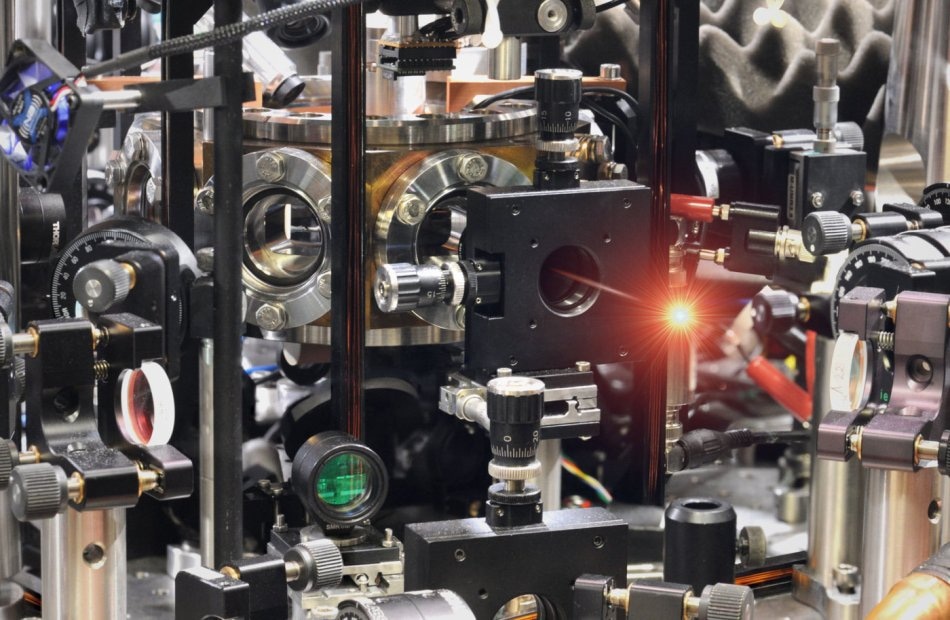Apr 30 2019
Quantum physicists can at present distill a type of photon schnapps. When distillation of spirits takes place, the alcohol content increases proportionate to the water content. A similar technique formulated by a team from the Max Planck Institute of Quantum Optics in Garching deals with light quanta – photons. It extracts separate photons from a light source, pushes back the undesirable vacuum component, and reports this event. Such solitary photons are vital quantum bits for the presently upcoming quantum information technology.
 Doesn’t quite look like a Schnapps distillery – the photon still in Garching. (© Severin Daiss/Quantum Dynamics Group)
Doesn’t quite look like a Schnapps distillery – the photon still in Garching. (© Severin Daiss/Quantum Dynamics Group)
It is certainly suggestive of the principle behind the distillation of alcohol – even though the device contained in a laboratory at the Max Planck Institute of Quantum Optics looks totally different from something employed for distilling schnapps. The Garching experiment increases the proportion of separate photons with regard to the vacuum. This motivation may sound odd to the common public. However, it leads straight to the unique world of quantum physics. Eventually, weak light sources that can supply precisely one photon play a vital role in quantum information technology. As a quantum bit, a photon can carry the elementary quantum information necessary for quantum encryption, quantum networks, and quantum computers – just as existing digital technology processes separate bits as information carriers.
The creation of single photon sources is a challenge that has been studied globally for numerous years. This sounds surprising because it takes just a single touch of a light switch to light up a room. However, the light from a lamp matches with a current of huge numbers of photons. If a light source is dimmed down to such an extent that just single photons can outflow from it, one is confronted with the roll-of-the-dice nature of the quantum realm; occasionally nothing comes, and then two or three photons come and so on. It is a little like the dripping from a still. It is hard to precisely predict when the drop will come or how large it will be.
No vacuum may be added to a cleanly prepared photon
The physicists from Gerhard Rempes’ Department at the Max Planck Institute of Quantum Optics had no plan of creating another single-photon light source. Rather, their experiment can extract separate photons from the light of any extremely weak light source – similar to a still – and consistently report this event. Rigidly speaking, it diminishes the fraction of pure vacuum compared to the event of attaining a photon. This insight is gained from Severin Daiss, doctoral student at the Institute and first author of the publication. One of the distinctiveness of the quantum realm is that the vacuum itself signifies a quantum state. If one wants to efficiently prepare a photon, vacuum must not be incorporated.
Two challenges join together in the new study effort of Rempes’ team. The first challenge is to acquire precisely one photon. The second is to dependably detect it. A single rubidium atom solves both challenges in a single step. This atom is in a type of mirror cabinet. More exactly, it is imprisoned between two nearly perfect mirrors facing each other. The distance of the mirrors in this “resonator” matches precisely to a multiple of half a wavelength of light wherein the atom could absorb or radiate its own photon. In this platform, the atom can be folded back and forth between two display positions similar to a pointer; this plays a crucial role here.
Several photon stills in succession increase the purity of the light
“We can use this system of the atom in the resonator as a still for the photon”, says Severin Daiss. The Garching-based group directs very weak laser light – from which they aim to get a single photon – onto the cavity. There it does something that only can happen in the quantum realm: It entangles with the atom-resonator set up, thus developing a common quantum state. This entangled state renders the system a still: With a measurement on the atom, physicists can extract an odd or an even number of photons from the incident light.
However, this does not function like a switch; the roll-of-the-dice nature of the quantum realm stops a photon from coming through at the click of a button.
What is decisive here is that we can now use the atom as a pointer to report a successful single-photon distillation”, explains Daiss.
Severin Daiss, First Author and Doctoral Student, Max Planck Institute of Quantum Optics.
The physicists allow the arrangement roll photons but ensure the dice count is reliably presented.
Along with ultra-weak light, the “odd photon number” mode can currently create events with one photon as more photons are seldom available. The distillation was successful with a “purity” of 66%, which means that the vacuum content was decreased to one third. Compared with single photon light sources, this is a worthy result for a first trial. This purity can be significantly raised with optimized optical cavities. The photon distilling elements can be linked in series in order to additionally increase the photon’s purity as it passes through. The quality of the light from other solitary photon sources can also be enhanced. It is like producing 60% (or higher) vodka from 40% vodka.